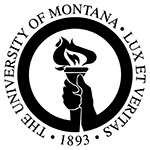
A mascot is any human, animal, or object thought to bring luck, or anything used to represent a group with a common public identity, such as a school, sports team, society, military unit, or brand name. Mascots are also used as fictional, representative spokespeople for consumer products.

The University of Montana (UM) is a public research university in Missoula, Montana. UM is a flagship institution of the Montana University System and its second largest campus. Fall 2024 saw total enrollment hit 10,811, marking the highest total enrollment for UM since 2018.

Andrew Rozdilsky Jr. was an American clown. As Andy the Clown, he was well-known for performing at Chicago White Sox games at the original Comiskey Park from 1960 to 1990.

Benny the Bull, commonly known as Benny, is the mascot of the National Basketball Association (NBA)'s Chicago Bulls, a role he has filled since 1969.

The Montana Grizzlies and Lady Griz are the nicknames given to the athletic teams of the University of Montana, located in Missoula. The university is a member of the Big Sky Conference and competes in NCAA Division I, fielding six men's teams and nine women's teams. The football team has won the university's only two NCAA championships.

The Montana Grizzlies football program represents the University of Montana in the Division I Football Championship Subdivision (FCS) of college football. The Grizzlies have competed in the Big Sky Conference since 1963, where it is a founding member. They play their home games on campus in Missoula at Washington–Grizzly Stadium, where they had an average attendance of 26,978 in 2023.
Cody Balogh is a former American football offensive lineman. He was signed by the Bears as an undrafted free agent in 2008. He played college football at Montana.
Robin Pflugrad is a retired American football coach. He was most recently the assistant head coach and tight ends coach at Northern Arizona University. He was the head coach for the University of Montana from 2010 to 2011 and the offensive coordinator at Weber State University in 2013. Pflugrad previously held assistant coaching positions at Montana, Oregon, Washington State, Arizona State, and Portland State.
The Montana Kaimin is the University of Montana's student-run independent newspaper located in Missoula, Montana. The paper is printed once a week, Thursday, with special editions printed occasionally and is online at MontanaKaimin.com. The Kaimin covers news, sports, arts and culture, and opinion.

Mount Sentinel, originally known as "Mount Woody," is a small mountain located immediately east of the University of Montana in Missoula, Montana. At a height of 1,958 feet and an elevation of 5,158 feet (1,572 m), Mount Sentinel also features the hillside letter "M", a large concrete structure 620 feet (189 m) up its western face.
The culture of Missoula, Montana is influenced by the nearby University of Montana in art, sports, and music with the city's location in a mountain river valley also encouraging outdoor events and recreation.
The 1979 Montana Grizzlies football team was an American football team that represented the University of Montana in the Big Sky Conference during the 1979 NCAA Division I-AA football season. In their fourth year under head coach Gene Carlson, the team compiled a 3–7 record.
The 1917 Montana football team represented the University of Montana in the 1917 college football season. They were led by third-year head coach Jerry Nissen, played their home games at Dornblaser Field, and finished the season with a record of one win and four losses (1–4).
The 1930 Montana Grizzlies football team represented the University of Montana in the 1930 college football season as a member of the Pacific Coast Conference (PCC). The Grizzlies were led by fifth-year head coach Frank W. Milburn, played their home games at Dornblaser Field and finished the season with a record of five wins and three losses.
The 1946 Montana Grizzlies football team represented the University of Montana in the 1946 college football season as a member of the Pacific Coast Conference (PCC). The Grizzlies were led by eighth-year head coach Doug Fessenden, played their home games at Dornblaser Field and finished the season with a record of four wins and four losses.
The 1947 Montana Grizzlies football team was an American football team that represented the University of Montana as a member of the Pacific Coast Conference (PCC) during the 1947 college football season.
The 1961 Montana Grizzlies football team represented the University of Montana in the 1961 college football season as a member of the Skyline Conference (Skyline). The Grizzlies were led by fourth-year head coach Ray Jenkins, played their home games at Dornblaser Field and finished the season with a record of two wins and six losses.

The 1990–91 Montana Grizzlies basketball team represented the University of Montana during the 1990–91 NCAA Division I basketball season. The Grizzlies were led by fifth-year head coach Stew Morrill and played their home games on campus at Adams Fieldhouse in Missoula, Montana.






